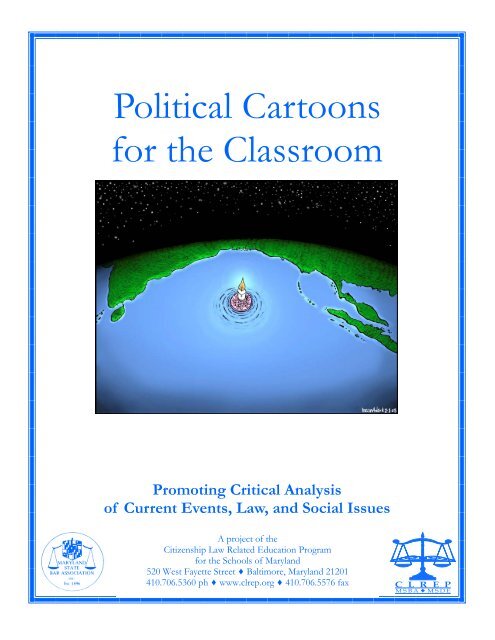political_cartoons
Catoons
Catoons
Create successful ePaper yourself
Turn your PDF publications into a flip-book with our unique Google optimized e-Paper software.
Political Cartoons<br />
for the Classroom<br />
Promoting Critical Analysis<br />
of Current Events, Law, and Social Issues<br />
A project of the<br />
Citizenship Law Related Education Program<br />
for the Schools of Maryland<br />
520 West Fayette Street ♦ Baltimore, Maryland 21201<br />
410.706.5360 ph ♦ www.clrep.org ♦ 410.706.5576 fax
Introduction<br />
For decades, <strong>political</strong> <strong>cartoons</strong> have proven to be effective, powerful learning tools that engage audiences of all<br />
backgrounds and ages. They provide concise, humorous (or heart-tugging), quick-witted snapshots of all kinds of<br />
issues—from politics and law to education and general humanitarian efforts. We have developed this publication in the<br />
hope that those on the “front line” of education will incorporate it into daily discussions with students on “the<br />
issues”—to spark debates, critical thinking, and comprehensive, careful analysis of events happening in the world<br />
around us.<br />
The positions expressed in these <strong>cartoons</strong> are not necessarily the position of CLREP or our staff. All <strong>cartoons</strong> in this<br />
publication are re-printed with the express written permission of Cagle Cartoons. If you wish to access additional<br />
<strong>political</strong> <strong>cartoons</strong>, we encourage you to visit www.<strong>political</strong><strong>cartoons</strong>.com — a comprehensive website that includes<br />
lesson plans and classroom resources on a wide array of subjects.<br />
Table of Contents<br />
Analyzing Political Cartoons<br />
(Student Worksheet)<br />
3<br />
Monsters Under the Bed Tsunami, War, Recent Events (2004-2005) 4<br />
2Fast Influence Movies, Teens, Fast Driving 5<br />
Fast Food Fast Food Lawsuits, “Overweight America” 6<br />
Cell Phones Driving Irresponsibly, Cell Phones 7<br />
Hollywood Message Media Influence, Weapons of Mass Destruction 8<br />
Network Programming Teens, Computers, Hacking 9<br />
Law School Diversity “Overweight America”, Smoking, Lawsuits 10<br />
More Soap Censorship, Media 11<br />
Assault Weapons Ban NRA, Supreme Court, Weapons Ban 12<br />
God Oaths Freedom of Religion, Separation of Church-State 13<br />
Pledge to Who? Pledge of Allegiance, Religion 14<br />
Diagram of a Liberal Liberal, John Kerry, “Left Wing” 15<br />
Halloween Costume Party Age of Supreme Court Justices 16<br />
Iraqi Ballot Box Bush, Iraq Elections 17<br />
I Hate Them Too Americans, Cultures, Attitudes 18<br />
Liberty Skirt Privacy, Government 19<br />
Supremes on Affirmative Action Affirmative Action, Supreme Court, quotas 20<br />
Violence in Schools Guns, violence, schools 21<br />
Juvenile Executions Death penalty, juveniles 22<br />
Silent Treatment Privacy, Right to Remain Silent 23<br />
You Are So Grounded President Clinton, 2 President Bush, broken world 24
Name: _____________________________<br />
Analyzing Political Cartoons: Student Worksheet<br />
Identifying the Main Idea<br />
1. To what <strong>political</strong> event or idea is the cartoon referring?<br />
2. What key person(s) are targeted in the cartoon?<br />
3. How has the artist depicted these people? Are they distorted in any way? Does the artist’s portrayal of<br />
characters cast them in a negative or positive light?<br />
4. Identify and explain any symbols incorporated in the cartoon.<br />
5. Identify and explain captions, labels, titles and/or speech bubbles. How do these contribute to the cartoon’s<br />
message?<br />
6. What is the message of the cartoon? How is the artist trying to persuade the reader?<br />
7. What impact and/or reaction is the artist attempting to trigger?<br />
Analyzing the Method Used by the Artist<br />
1. How does the method used by the artist effectively convey a <strong>political</strong> message?<br />
2. Identify and explain the use of:<br />
a. Juxtaposition (the state of being side by side or close together, in a figurative sense)<br />
b. Irony (the use of words or pictures to express something different from, and often opposite of<br />
their literal meaning)<br />
c. Exaggeration (representation as greater than is actually the case; overstatement)<br />
3
Artist: Tab<br />
4
Artist: Cam Cardow<br />
5
Artist: Cam Cardow<br />
6
Artist: Mike Keefe<br />
7
Artist: Larry Wright<br />
8
Artist: Mike Keefe<br />
9
Artist: Larry Wright<br />
10
Artist: Larry Wright<br />
11
Artist: Mike Keefe<br />
12
Artist: Jeff Parker<br />
13
Artist: Brian Farrington<br />
14
Artist: Brian Farrington<br />
15
Artist: Bob Englehart<br />
16
Artist: Best of Latin America<br />
17
Artist: Daryl Cagle<br />
18
Artist: Best of Latin America<br />
19
Artist: Mike Keefe<br />
20
Artist: Best of Latin America<br />
21
Artist: Mike Keefe<br />
22
Artist: Mike Lester<br />
23
Artist: M. E. Cohen<br />
24



